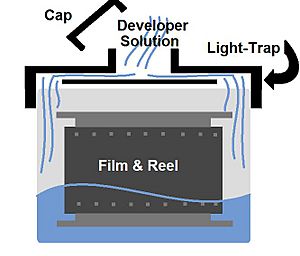Film processing facts for kids
Have you ever wondered how old photos were made before digital cameras? It all started with a special kind of film that could capture images. But to actually see those images, the film had to go through a series of chemical processes. This whole process is called film processing or developing.
Think of it like magic! The chemicals make the hidden image on the film appear. After that, other chemicals make sure the image stays visible and doesn't fade away. Different types of film, like black and white film or color slide film, need slightly different chemical steps.
Contents
What is Film Processing?
Film processing is the way we turn a hidden image on photographic film into something you can actually see. When you take a picture with a film camera, light hits the film and creates a "latent image." This image is invisible! The processing steps use special liquids to make that hidden image appear.
How Does Film Processing Work?
The process usually involves a few main steps:
- Developing: First, the film goes into a chemical called a developer. This chemical reacts with the parts of the film that were hit by light, making the image visible.
- Stopping: After developing, the film is rinsed or put into a "stop bath." This stops the developing process so the image doesn't get too dark.
- Fixing: Next, the film goes into a "fixer" chemical. This step makes the image permanent. It removes any parts of the film that weren't exposed to light or developed. This means the image won't change or fade when it's exposed to light later.
- Washing: Finally, the film is washed with water to remove all the chemicals. This helps the image last a very long time.
Types of Film and Their Results
There are two main types of film that give different results:
- Negative Film: This is the most common type. When you develop negative film, all the colors and brightness are reversed. Dark areas look light, and light areas look dark. Colors are also opposite (for example, blue might look yellow). To get a normal picture, you need to make a print from the negative. The printing process reverses everything again, so you see the image correctly.
- Reversal Film (Slide Film): This film is special because it directly produces a positive image. This means the colors and brightness are exactly as they were in real life. These positive images are often called diapositives or slides. They are usually put into frames and can be projected onto a screen to be viewed.
Images for kids
-
Key stages in production of Ag-based photographs. Two silver halide particles, one of which is impinged with light (hν) resulting in the formation of a latent image (step 1). The latent image is amplified using photographic developers, converting the silver halide crystal to an opaque particle of silver metal (step 2). Finally, the remaining silver halide is removed by fixing (step 3).
-
Black and white negative processing is the chemical means by which photographic film and paper is treated after photographic exposure to produce a negative or positive image. Photographic processing transforms the latent image into a visible image, makes this permanent and renders it insensitive to light.
See also
 In Spanish: Revelado fotográfico para niños
In Spanish: Revelado fotográfico para niños


